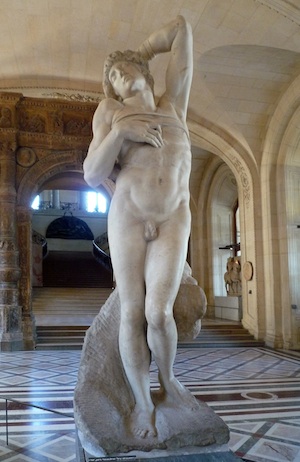5.23: Miguel Ángel Introducido
- Page ID
- 103257
Miguel Ángel era conocido como il divino, (en inglés, “the divine one”) y es fácil para nosotros ver por qué. Tanto de lo que él creó nos parece sobrehumano.

Cuando Miguel Ángel tenía veintitantos años, esculpió al David de 17 pies de altura. Este coloso le pareció a sus contemporáneos rivalizar o incluso superar la escultura antigua griega y romana. David, y sus esculturas posteriores como Moisés y los esclavos, demostraron la asombrosa capacidad de Miguel Ángel para hacer que el mármol pareciera carne y hueso vivos. Tanto es así, es difícil imaginar que estos fueron creados con un martillo y un cincel.
En la pintura, si miramos el techo de la Capilla Sixtina en Roma, con sus elegantes desnudos y poderosas figuras sentadas, y la imagen ahora icónica de la Creación de Adán, Miguel Ángel estableció un nuevo estándar para pintar la figura humana, una en la que el cuerpo no era solo un actor en una narrativa, sino emocional y espiritualmente expresivo por sí mismo.
Y luego está su arquitectura, donde Miguel Ángel reordenó formas antiguas de una manera completamente nueva y dramática.
No es de extrañar entonces también, que Vasari, que conocía a Miguel Ángel, escribiera sobre cómo Miguel Ángel sobresalió en las tres artes: pintura, escultura y arquitectura:
El gran Gobernante del Cielo miró hacia abajo y.. resuelto.. para enviar a la tierra un genio universal en cada arte.. Además le dotó de verdadera filosofía moral y de un dulce espíritu poético, para que el mundo se maravillara con la singular eminencia de su vida y obra y de todas sus acciones, pareciendo más bien divinas que terrosas.
Miguel Ángel también fue poeta. En el poema de abajo, Miguel Ángel nos da un sentido de la coexistencia en su arte de un amor tanto al cuerpo humano (particularmente masculino) como a Dios.
La escultura, la primera de las artes, deleita a un gusto
Aún fuerte y sonoro: cada acto, cada extremidad, cada hueso
Se le da vida y, he aquí, se levanta el cuerpo del hombre,
Respirando vivo, en cera o arcilla o piedra.
Pero oh, si la ira inclemente del tiempo se desperdiciara,
O mutilar, la estatua que el hombre construye solo,
Su belleza aún permanece, y se puede rastrear Volver a la fuente que la reclama como propia.
Colaboradores
- Miguel Ángel: Escultor, Pintor, Arquitecto y Poeta. Proporcionado por: Khan Academy. Ubicado en: https://web.archive.org/web/20140215023806/http://smarthistory.khanacademy.org/michelangelo.html. Licencia: CC BY-NC-SA: Atribución-NoComercial-CompartirIgual

